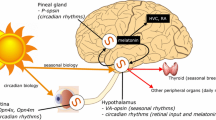Abstract
Light conditions were studied in six lakes of the Danube Delta for a period of 2 years and were described as a function of 12 independent variables forming a data matrix with more than 1000 sample units. Light extinction was explained in percentage of 64% by phytoplankton, of 11% by detritus, of 7% by zooplankton, of 1.4% by dissolved organic matter and of 0.15 by bacterioplankton. The influence of mineral particles was insignificant. Equations are produced here for the relationship to water turbulence, wind intensity and lake depth. The threshold for full water turbulence was between 7 and 8% for a fluctuation domain of critical winds of 3.2–5.4 m s-1 and for a depth domain of 1–3 m.
Similar content being viewed by others
References
Best Elly, P. H., 1981. A primary model for growth of Ceratophyllum demersum L., Verh. int. Ver. Limnol. 21: 1484–1491.
Bondar, C., 1965. Wave elements characteristics on the lakes of the Romanian Littoral, Hydraulic research (Bucharest), IX: 113–135.
Cristofor, S., 1987. L'évolution de l'état trophique des ecosystèmes aquatiques caractéristiques du Delta du Danube. 6. Réponses de la végétation submerse en fonction de la réserve de nutrients et du régime hydrologique, Rev. Roum. Biol.-Biol. Anim. 32: 129–138.
Ikusima, I., 1970. Ecological studies on the productivity of aquatic plant communities. IV. Light conditions and community photosynthetic production, Bot. Mag. 83: 330–341.
Karabin, A., 1985. Pelagic zooplankton (Rotatoria + Crustacea) variation in the process of lake eutrophication. I. Structural and quantitative featurea, Ekol. pol. 33:567–616.
Matusiak, K. & I. Wojciechowski, 1975. Some physical factors as ecological background in the pelagial of the Sosnowichie Lakes, Acta Hydrobiol. 17: 103–139.
Pelletier, J. P., 1984. Essai d'évaluation de la production phytoplanctonique du Lac Leman à partir de la biomasse et de l'énergie incidente, Verh. int. Ver. Limnol., 22: 1047–1051.
Riber, Hans., 1984. Phosphorus uptake from water by the macrophyte-epiphyte complex in a Danish lake: Relationship to phytoplankton. Verh. int. Verein. Limnol. (Stuttgart), 22: 790–794.
Szczepanski, A., 1968. Scattering of light and visibility in water of different types of lakes. Pol. Arch. Hydrobiol. 15: 51–77.
Vadineanu, A., S. Cristofor, D. Nicolescu, C. Dorobantu & L. Gavrila, 1987. L'évolution de l'état trophique des écosystèmes aquatiques caractéristiques du Delta du Danube. 3. La dynamique du carbone organique particule et de ses fractions. Rev. Roum. Biol.-Biol. Anim. 32: 99–109.
Weisser, P. J., 1978. A conceptual model of a siltation system in shallow lakes with littoral vegetation. J. Limnol. Soc. Sth. Afr. 4: 145–149.
Author information
Authors and Affiliations
Rights and permissions
About this article
Cite this article
Cristofor, S., Vadineanu, A., Ignat, G. et al. Factors affecting light penetration in shallow lakes. Hydrobiologia 275, 493–498 (1994). https://doi.org/10.1007/BF00026737
Issue Date:
DOI: https://doi.org/10.1007/BF00026737




